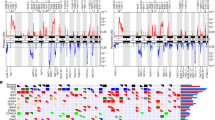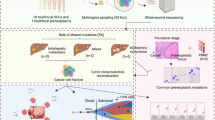Abstract
Aims
To clarify the incidence of multicentric occurrence (MO) and intrahepatic metastasis (IM) for hepatocellular carcinoma (HCC) related to hepatitis B virus in China and to identify the differences between them.
Methods
Histopathologic and genetic features of primary and recurrent tumors in 160 cases with HCC were analyzed. The two groups, the origin of which was definitely determinable as of multicentric occurrence or as of intrahepatic metastasis, were analyzed for their disease-free survival and clinicopathological differences.
Results
According to histopathological findings, 27.5% and 59.4% patients were considered to be MO and IM, respectively. By comparing the genetic information of loss of heterozygosity and microsatellite instability for 10 different markers between primary and recurrent tumor, 30.0% and 63.8% patients with recurrent HCC were considered to be MO and IM, respectively. In total, 126 cases with unanimous conclusions from the histopathological and genetic method were selected and divided into the MO group (37 cases) and the IM group (89 cases). Analysis of stepwise regression identified that recurrence time, grading, portal vein invasion, tumor number, and Child’s stage were the most important discriminating factors between MO and IM (p < 0.05). As for their prognosis, Kaplan–Meier and log rank test showed that the disease-free survival in the MO group was significantly better than in the IM group (p = 0.002).
Conclusions
Combined analysis of histopathological and genetic analysis may reflect more exactly the nature of recurrent HCC. The incidence of MO in China is lower than in other countries—30% compared to up to 50% in Japan [Morimoto et al., Journal of Hepatology 39:215–221, 2003; Yamamoto et al., Hepatology 29;1446–1452, 1999]. Recurrence time, tumor grading, portal vein invasion, tumor number, and Child’s stage are the most important discriminating factors between MO and IM. The prognosis (disease-free survival) of patients with MO compared to IM is significantly better.


Similar content being viewed by others
References
Manno M, Camma C, Schepis F, et al. Natural history of chronic HBV carriers in northern Italy: morbidity and mortality after 30 years. Gastroenterology 2004;127:756–763. doi:10.1053/j.gastro.2004.06.021.
Hao XS, Wang PP, Chen KX, et al. Twenty-year trends of primary liver cancer incidence rates in an urban Chinese population. Eur J Cancer Prev 2003;12:273–279. doi:10.1097/00008469-200308000-00006.
Momosaki S, Nakashima Y, Kojiro M, et al. HBsAg-negative hepatitis B virus infections in hepatitis C virus-associated hepatocellular carcinoma. J Viral Hepatitis 2005;12:325–329. doi:10.1111/j.1365-2893.2005.00586.x.
Tokita H, Fukui H, Tanaka A, et al. Risk factors for the development of hepatocellular carcinoma among patients with chronic hepatitis C who achieved a sustained virological response to interferon therapy. J Gastroenterol Hepatol 2005;20:752–758. doi:10.1111/j.1440-1746.2005.03800.x.
Qiang L, Huikai L, Butt K, et al. Factors associated with disease survival after surgical resection in Chinese patients with hepatocellular carcinoma. World J Surg 2006;30:439–445. doi:10.1007/s00268-005-0608-6.
Maruyama K, Kaminishi M, Hayashi K, et al. Gastric cancer treated in 1991 in Japan: data analysis of nationwide registry. Gastric Cancer 2006;9:51–66. doi:10.1007/s10120-006-0370-y.
Birgisson H, Talback M, Gunnarsson U, et al. Improved survival in cancer of the colon and rectum in Sweden. Eur J Surg Oncol 2005;31:845–853. doi:10.1016/j.ejso.2005.05.002.
Takenaka K, Adachi E, Nishizaki T, et al. Possible multicentric occurrence of hepatocellular carcinoma: a clinicopathological study. Hepatology 1994;19:889–894.
Kumada T, Nakano S, Takeda I, et al. Patterns of recurrence after initial treatment in patients with small hepatocellular carcinoma. Hepatology 1997;25:87–92. doi:10.1002/hep.510250116.
Arii S, Monden K, Niwano M, et al. Results of surgical treatment for recurrent hepatocellular carcinoma: comparison of outcome among patients with multicentric carcinogenesis, intrahepatic metastasis, and extrahepatic recurrence. J Hepatobiliary Pancreat Surg 1998;5:86–92. doi:10.1007/PL00009956.
Poon RTP, Fan ST, Ng IOL, et al. Different risk factors and prognosis for early and late intrahepatic recurrence after resection of hepatocellular carcinoma. Cancer 2000;89:500–507. doi:10.1002/1097-0142(20000801)89:3<500::AID-CNCR4>3.0.CO;2-O.
Matsuda M, Fujii H, Kono H, et al. Surgical treatment of recurrent hepatocellular carcinoma based on the mode of recurrence: repeat hepatic resection or ablation are good choices for patients with recurrent multicentric cancer. J Hepatobiliary Pancreat Surg 2001;8:353–359. doi:10.1007/s005340170008.
Yasui M, Harada A, Nonami T, et al. Potentially multicentric hepatocellular carcinoma: clinicopathologic characteristics and postoperative prognosis. World J Surg 1997;21:860–864. doi:10.1007/s002689900318.
Chen YJ, Yeh SH, Chen JT, et al. Chromosomal changes and clonality relationship between primary and recurrent hepatocellular carcinoma. Gastroenterology 2000;119:31–40.
Morimoto O, Nagano H, Sakon M, et al. Diagnosis of intrahepatic metastasis and multicentric carcinogenesis by microsatellite loss of heterozygosity in patients with multiple and recurrent hepatocellular carcinomas. J Hepatol 2003;39:215–221. doi:10.1016/S0168-8278(03)00233-2.
Yang B, Zhenggang R. The diagnostic criteria of primary HCC. Chinese Journal of Hepatology 2000;8:135.
Wong CM, Lee JM, Lau RC, et al. Clinicopathological significance of loss of heterozygosity on chromosome 13q in hepatocellular carcinoma. Clin Cancer Res 2002;8:2266–2272.
Piao Z, Kim H, Malkhosyan S, et al. Frequent chromosomal instability but no microsatellite instability in hepatocellular carcinoma. Int J Oncol 2000;17:507–512.
Kahng YS, Lee YS, Kim BK, et al. Loss of heterozygosity of chromosome 8p and 11p in the dysplastic nodule and hepatocellular carcinoma. J Gastroenterol Hepatol 2003;18:430–436. doi:10.1046/j.1440-1746.2003.02997.x.
Lin YW, Lee HS, Chen CH, et al. Clonality analysis of multiple hepatocellular carcinomas by loss of heterozygosity pattern determined by chromosomes 16q and 13q. J Gastroenterol Hepatol 2005;20:536–546. doi:10.1111/j.1440-1746.2005.03609.x.
Ng IO, Guan XY, Poon RT, et al. Determination of the molecular relationship between multiple tumour nodules in hepatocellular carcinoma differentiates multicentric origin from intrahepatic metastasis. J Pathol 2003;199:345–353. doi:10.1002/path.1287.
Morimoto O, Nagano H, Sakon M, et al. Diagnosis of intrahepatic metastasis and multicentric carcinogenesis by microsatellite loss of heterozygosity in patients with multiple and recurrent hepatocellular carcinomas. J Hepatol 2003;39:215–221. doi:10.1016/S0168-8278(03)00233-2.
Yamamoto T, Kajino K, Kudo M, et al. Determination of the clonal origin of multiple human hepatocellular carcinomas by cloning and polymerase chain reaction of the integrated hepatitis B virus DNA. Hepatology 1999;29:1446–1452. doi:10.1002/hep.510290523.
McCormack L, Petrowsky H, Clavien P-A. Surgical therapy of hepatocellular carcinoma. J Gastroenterol Hepatol 2005;17:497–503. doi:10.1097/00042737-200505000-00005.
Shimamatsu K, Kage M, Nakashima O, et al. Pathomorphological study of HCV antibody-positive liver cirrhosis. J Gastroenterol Hepatol 1994;9:623–630. doi:10.1111/j.1440-1746.1994.tb01572.x.
Tarao K, Hoshino H, Shimizu A, Ohkawa S, Nakamura Y, Harada M, et al. Role of increased DNA synthesis activity of hepatocytes in multicentric hepatocarcinogenesis in residual liver of hepatectomized cirrhotic patients with hepatocellular carcinoma. Jpn J Cancer Res 1994;85:1040–1044.
Koike K, Moriya K, Kimura S. Role of hepatitis C virus in the development of hepatocellular carcinoma: transgenic approach to viral hepatocarcinogenesis. J Gastroenterol Hepatol 2002;17:394–400. doi:10.1046/j.1440-1746.2002.02763.x.
Ueno S, Aoki D, Maeda T, et al. Preoperative assessment of multicentric occurrence in synchronous small and multiple hepatocellular carcinoma based on image-patterns and histological grading of non-cancerous region. Hepatol Res. 2004;29:24–30. doi:10.1016/j.hepres.2004.02.003.
Acknowledgment
We thank Prof. Baocun Sun and Prof. Hongda Ma for the study of pathology. This study was supported by grants from the Tianjin Municipal Science and Technology Commission, China (No 06YFJMJC08400).
Author information
Authors and Affiliations
Corresponding author
Rights and permissions
About this article
Cite this article
Li, Q., Wang, J., Juzi, J.T. et al. Clonality Analysis for Multicentric Origin and Intrahepatic Metastasis in Recurrent and Primary Hepatocellular Carcinoma. J Gastrointest Surg 12, 1540–1547 (2008). https://doi.org/10.1007/s11605-008-0591-y
Received:
Accepted:
Published:
Issue Date:
DOI: https://doi.org/10.1007/s11605-008-0591-y




